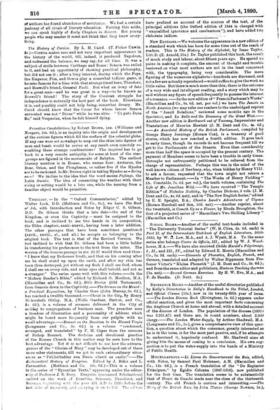THEOLOGY. — In the "Oxford Commentaries," edited by Walter Lock,
D.D. (Methuen and Co., 6s.), we have The Book of Job, with Introduction and Notes by Edgar C. S. Gibson, D.D. Dr. Gibson thinks that a late date—the end of the Kingdom, or even the Captivity — must be assigned to the book, and is inclined to see two hands in its composition, the Elihu chapters, xxxii.-xxxvii., having been a later addition. The other passages that have been sometimes questioned (xxvii., xxviii., xl., and xli.) he accepts as belonging to the original book. The text is that of the Revised Version. We feel inclined to wish that Dr. Gibson had been a little bolder in transferring his preferences to the text from the notes. The version of tile famous passage in six. 25-27 would then read thus : I know that my Redeemer liveth, and that on his coming after me he shall stand up upon the earth, and after my skin has been thus destroyed, yet without my flesh I shall see God, whom I shall see on every side, and mine eyes shall behold, and not as a stranger." The series opens well with this volume.—In the " Modern Reader's Bible," edited by Richard G. Moulton, M.A. (Macmillan and Co., 2s. 6d.), Bible Stories (Old Testament), from Genesis down to the Captivity.—The Sermon on the Mount : a Practical Exposition, by Charles Gore (John Murray, 3s. 6d.), has reached a twelfth thousand.—Christ in the City, IV Henry Biekersteth Ottley, M.A. (Wells Gardner, Darton, and Co., 21. 6d.), is a volume of sermons delivered in the City at midday to congregations of business men. The preacher uses a freedom of illustration and a personality of address which might be heard more frequently from our pulpits with no small advantage.—Bossust on the Devotion to the Blessed Virgin (Longmans and Co., 3s. 6d.) is a volume "condensed, arranged, and translated" by F. M. Capes from the sermons of Bishop Bossuet. The doctrine and devotional practice of the Roman Church in this matter may be seen here to the best advantage. Yet it is not difficult to see how the extrava- gances of the "Glories of Mary" may be developed out of these snore sober statements, till we get to such extraordinary utter- ances as " Pulchritudino sua Daum allexit ex caelis."—The Bcclesiastical History of Eva gnus. Edited by .J. Bidez and L. Partnentier. (Methuen and Co. 10s. 6d.)—This is a volume in the series of "Byzantine Texts," appearing under the editor- leliD of Professor J. B. Bury. Evagrius (surnamed Scholasticus) carried on the work of Eusebius, Sozomen, Theodoret, and Soerate, I.,Tinning with the year 431 A.D. (a little before the last date of Socrates), ani ca i vying it on to 593. The eirtors have prefixed an account of the sources of the text, of the principal editions (the Oxford edition of 1844 is charged with "unqualified ignorance and carelessness") and have added two
elaborate indices. • _






































 Previous page
Previous page